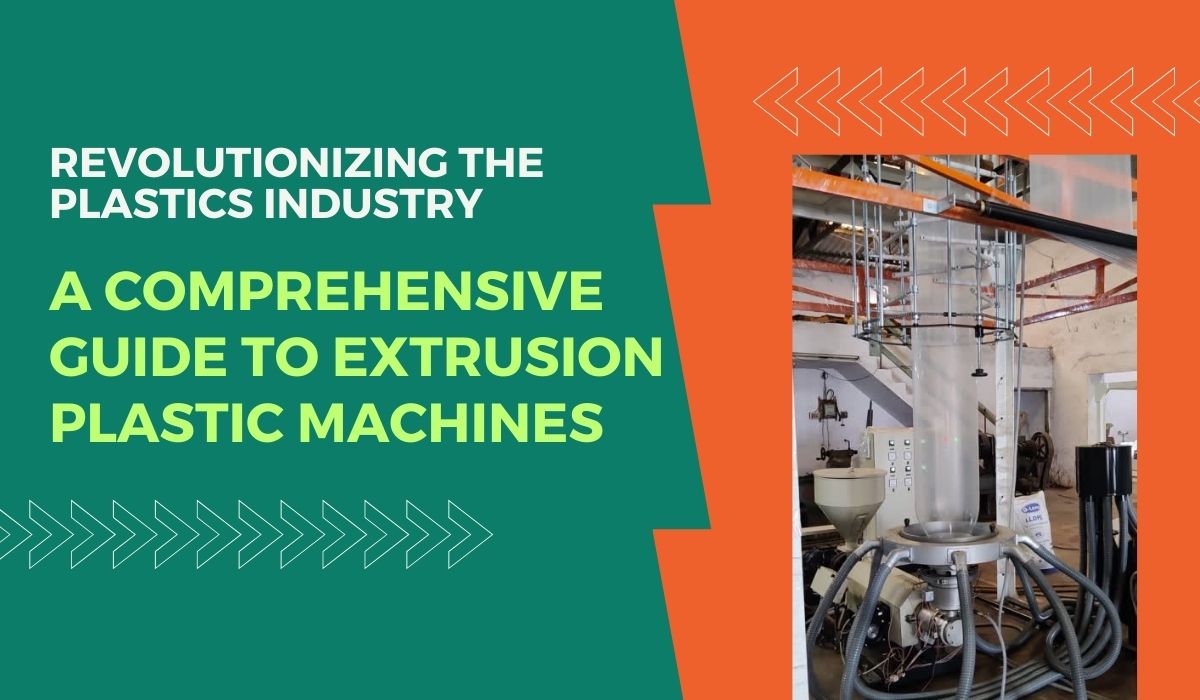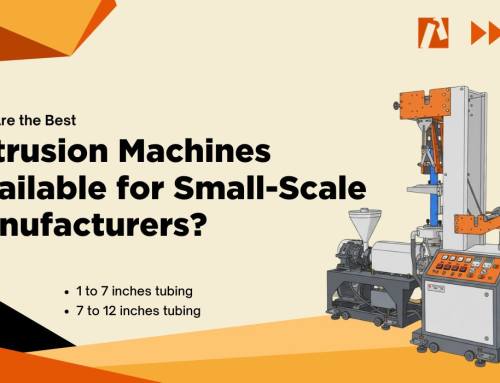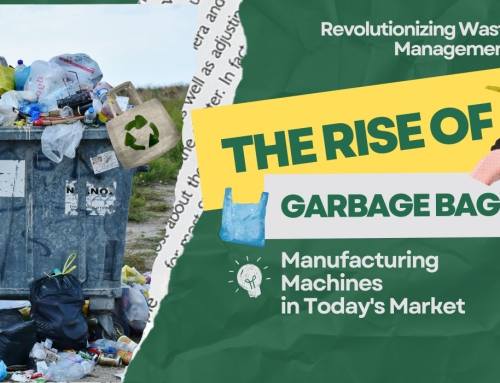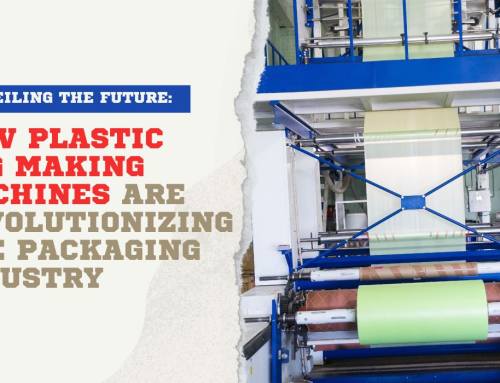Are you ready to dive into the world of extrusion plastic machines and discover how they are revolutionizing the plastics industry? Look no further! In this comprehensive guide, we will explore the ins and outs of these cutting-edge machines, providing you with a complete understanding of their capabilities and applications.
From the manufacturing of everyday plastic products to creating intricate parts for aerospace and automotive industries, extrusion plastic machines have become an integral part of modern production processes. With their ability to shape and mold plastic materials into various forms, these machines have opened up endless possibilities for designers, engineers, and manufacturers.
Throughout this guide, we will delve into the different types of extrusion plastic machines, their operating principles, and the materials they can work with. We’ll also explore the advantages and limitations of these machines, as well as their impact on environmental sustainability.
Join us as we uncover the exciting world of extrusion plastic machines, and learn how they are shaping the future of the plastics industry. Whether you’re a seasoned professional or just starting out in the field, this guide is for you!
The importance of extrusion plastic machines in the plastics industry
Extrusion plastic machines have become the backbone of the plastics industry, revolutionizing the way plastic products are manufactured. These versatile machines play a crucial role in transforming raw plastic materials into a wide range of consumer and industrial goods, from everyday household items to highly specialized components for various industries.
The importance of extrusion plastic machines lies in their ability to efficiently and consistently produce large quantities of plastic products with precise control over the final shape, size, and properties. The extrusion process allows for the continuous production of plastic parts, enabling manufacturers to meet the ever-increasing demand for plastic-based products across diverse sectors, including packaging, construction, automotive, and electronics.
Furthermore, advancements in extrusion technology have led to improved energy efficiency, reduced material wastage, and enhanced environmental sustainability, making these machines an integral part of the plastics industry’s efforts to promote sustainable manufacturing practices. As the global focus on environmental conservation and circular economy grows, the role of extrusion plastic machines in the plastics industry becomes even more crucial, as they enable the production of recyclable and eco-friendly plastic products.
Types of extrusion plastic machines
The plastics industry utilizes a variety of extrusion plastic machines, each designed to handle specific types of plastic materials and produce a range of plastic products. The most common types of extrusion plastic machines include:
- Single-screw extruders: These are the most widely used extrusion machines, featuring a single, rotating screw that transports, melts, and homogenizes the plastic material before it is forced through a die to create the desired shape.
- Twin-screw extruders: These machines employ two counter-rotating screws that work together to provide enhanced mixing and compounding capabilities, making them suitable for processing more complex plastic formulations and blends.
- Blown film extruders: Designed for the production of plastic films, these extruders use a circular die to extrude a continuous tube of molten plastic, which is then inflated and stretched to create thin, uniform film sheets.
- Pipe and profile extruders: These specialized extruders are used to manufacture a variety of plastic pipes, rods, and other profile shapes, often with complex cross-sections or intricate designs.
- Sheet extruders: These machines produce flat, continuous sheets of plastic material, which can then be used for thermoforming, lamination, or other secondary processing operations.
- Coextrusion machines: These advanced extruders are capable of simultaneously extruding multiple layers of different plastic materials, allowing for the creation of complex, multilayered products such as packaging films, pipes, and sheets.
Each type of extrusion plastic machine is tailored to specific applications, catering to the unique requirements of the plastics industry and the end-users of the plastic products. Understanding the capabilities and limitations of these machines is crucial for selecting the appropriate equipment for a given manufacturing process.
Components of an extrusion plastic machine
At the core of an extrusion plastic machine are several key components that work together to transform raw plastic materials into the desired final product. These components include:
- Hopper: The hopper is the entry point for the plastic raw material, which is typically in the form of pellets, granules, or powders. It ensures a consistent and controlled flow of material into the extruder.
- Extruder barrel: The extruder barrel is a cylindrical housing that contains the rotating screw (or screws, in the case of twin-screw extruders). This barrel is typically made of hardened steel and is equipped with heating elements to melt the plastic material.
- Screw: The screw is the heart of the extrusion process, responsible for transporting, melting, and homogenizing the plastic material. The design and configuration of the screw, including its length, diameter, and flight geometry, can significantly impact the efficiency and quality of the extrusion process.
- Die: The die is the shaping component of the extrusion machine, determining the final cross-sectional shape of the extruded product. Dies can be designed in a variety of shapes and sizes to accommodate different product requirements.
- Cooling system: After the molten plastic material is extruded through the die, it needs to be cooled and solidified. This is typically achieved through a cooling system, such as water baths or air-cooling systems, to ensure the final product maintains its desired shape and properties.
- Haul-off and cutting system: The haul-off system pulls the extruded product away from the die at a controlled speed, while the cutting system, often using rotating blades or saws, cuts the continuous extrudate into the desired lengths or shapes.
- Control systems: Modern extrusion plastic machines are equipped with advanced control systems, including programmable logic controllers (PLCs) and human-machine interfaces (HMIs), which allow for precise control over the extrusion process parameters, such as temperature, pressure, and speed.
These core components work in harmony to transform raw plastic materials into a wide range of products, from simple plastic films to complex profiles and pipes. Understanding the function and interplay of these components is crucial for operating and maintaining extrusion plastic machines effectively.
How extrusion plastic machines work
The extrusion process in plastic machines involves a series of steps that transform raw plastic materials into the desired final product. The process typically follows these key steps:
- Feeding the raw material: The plastic raw material, usually in the form of pellets, granules, or powders, is fed into the hopper of the extrusion machine. The hopper ensures a consistent and controlled flow of the material into the extruder barrel.
- Melting and mixing: As the material enters the extruder barrel, it is subjected to a combination of heat and mechanical shear force generated by the rotating screw. This process melts and homogenizes the plastic, creating a uniform, molten mixture.
- Conveying and pressurizing: The rotating screw transports the molten plastic material along the barrel, building up pressure and forcing the material towards the die. This pressure helps to ensure a consistent and continuous flow of the material through the die.
- Shaping and forming: The molten plastic material is then extruded through the die, which gives the product its desired shape and cross-sectional profile. The die’s design and configuration play a crucial role in determining the final shape and dimensions of the extruded product.
- Cooling and solidification: After passing through the die, the extruded product is cooled, either through a water bath or an air-cooling system, to solidify the plastic and maintain the desired shape and properties.
- Haul-off and cutting: The solidified extruded product is then pulled away from the die by the haul-off system, which controls the speed and tension of the material. The cutting system then cuts the continuous extrudate into the required lengths or shapes.
- Post-processing: Depending on the specific application, the extruded product may undergo additional post-processing steps, such as surface finishing, printing, or further shaping and assembly, to meet the final product requirements.
Throughout the extrusion process, the machine’s control systems monitor and adjust various parameters, such as temperature, pressure, and speed, to ensure the consistent production of high-quality plastic products. Understanding the intricacies of this process is crucial for optimizing the performance of extrusion plastic machines and maximizing their efficiency.
Advantages of using extrusion plastic machines
Extrusion plastic machines offer a range of advantages that have made them an indispensable part of the plastics industry. Some of the key advantages include:
- Continuous production: Extrusion machines enable the continuous, high-volume production of plastic products, allowing manufacturers to meet the growing demand for plastic-based goods efficiently and cost-effectively.
- Versatility: Extrusion machines can handle a wide variety of plastic materials, from thermoplastics like polyethylene and polypropylene to more specialized materials like engineering plastics and composites. This versatility allows manufacturers to cater to diverse market needs.
- Precise control: Extrusion machines provide precise control over the extrusion process, enabling the production of plastic parts and products with consistent quality, dimensions, and properties. This level of control is crucial for meeting the stringent requirements of various industries.
- Energy efficiency: Advancements in extrusion technology have led to improvements in energy efficiency, reducing the overall energy consumption and operating costs associated with plastic production.
- Reduced material waste: Extrusion machines are designed to minimize material waste, as the continuous nature of the process allows for efficient utilization of raw materials. This contributes to the overall sustainability of the plastics industry.
- Customization: Extrusion machines can be tailored to specific manufacturing needs, with the ability to accommodate custom die designs, screw configurations, and other process parameters to meet the unique requirements of different applications.
- Cost-effectiveness: Compared to other plastic manufacturing processes, extrusion is generally a more cost-effective option, particularly for high-volume production runs. This makes it an attractive choice for a wide range of industries and applications.
These advantages have made extrusion plastic machines an integral part of the modern plastics industry, driving innovation, efficiency, and sustainability in the production of a vast array of plastic products.
Common applications of extrusion plastic machines
Extrusion plastic machines have a wide range of applications across various industries, contributing to the production of countless everyday items and specialized components. Some of the most common applications of these versatile machines include:
- Packaging: Extrusion machines are extensively used in the production of plastic packaging materials, such as films, sheets, and rigid containers for food, beverages, pharmaceuticals, and consumer goods.
- Construction: Extrusion machines are employed in the manufacture of plastic pipes, profiles, and other building materials used in the construction industry, including PVC window frames, siding, and insulation products.
- Automotive: Extrusion machines play a crucial role in the automotive industry, producing plastic parts and components for vehicles, including dashboards, door panels, bumpers, and interior trim.
- Electronics: Extrusion processes are used to create a wide range of plastic enclosures, housings, and components for electronic devices, such as computers, smartphones, and household appliances.
- Medical: Extrusion machines are utilized in the production of medical devices, including tubing, catheters, and other specialized components used in the healthcare industry.
- Telecommunications: Extrusion technology is employed in the manufacture of plastic conduits, cables, and other infrastructure components for the telecommunications industry.
- Consumer goods: Extrusion machines are used to produce a variety of everyday consumer products, such as plastic bags, toys, utensils, and household items.
- Industrial applications: Extrusion processes are utilized in the production of industrial parts, components, and profiles made from engineering plastics, which are used in machinery, equipment, and other industrial applications.
The versatility of extrusion plastic machines, coupled with their ability to handle a wide range of plastic materials, has made them an indispensable tool in the manufacturing of countless products that are essential to modern life. As the plastics industry continues to evolve, the applications of these machines will only continue to expand.
Factors to consider when choosing an extrusion plastic machine
When selecting an extrusion plastic machine for a specific manufacturing process, there are several key factors that should be carefully considered to ensure the optimal performance and efficiency of the equipment. These factors include:
- Plastic material requirements: The type of plastic material, its physical and chemical properties, and the desired final product characteristics are crucial in determining the appropriate extrusion machine and its configuration. Factors such as melt flow index, viscosity, and thermal stability must be taken into account.
- Production volume and output: The required production volume and output rate will influence the size and capacity of the extrusion machine, as well as the number of extruders needed to meet the production demands.
- Die design and configuration: The shape, size, and complexity of the desired final product will dictate the die design and configuration, which must be carefully matched to the extrusion machine’s capabilities.
- Energy efficiency and sustainability: As the industry focuses on environmental sustainability, the energy efficiency and environmental impact of the extrusion machine, including its energy consumption, emissions, and waste management, should be considered.
- Automation and control systems: Advanced control systems, such as programmable logic controllers (PLCs) and human-machine interfaces (HMIs), can enhance the precision, consistency, and efficiency of the extrusion process, making them an important factor in the machine selection.
- Maintenance and service requirements: The ease of maintenance, availability of spare parts, and the quality of after-sales service and support provided by the machine manufacturer are crucial considerations to ensure the long-term reliability and performance of the extrusion equipment.
- Cost and return on investment: The initial capital investment, as well as the ongoing operating and maintenance costs, must be weighed against the expected productivity, efficiency, and profitability of the extrusion machine to ensure a favorable return on investment.
By carefully evaluating these factors, manufacturers can select the most suitable extrusion plastic machine for their specific production needs, ensuring optimal performance, quality, and cost-effectiveness in their plastic manufacturing operations.
Maintenance and troubleshooting tips for extrusion plastic machines
To ensure the long-term reliability and efficient operation of extrusion plastic machines, proper maintenance and timely troubleshooting are essential. Here are some key tips to help maintain and troubleshoot these critical pieces of equipment:
- Preventive maintenance: Establish a comprehensive preventive maintenance program that includes regular inspections, cleaning, and replacement of wear parts, such as screws, barrels, and dies. This helps to minimize downtime and maintain optimal machine performance.
- Lubrication and cooling systems: Regularly check and maintain the lubrication and cooling systems to ensure they are functioning correctly. Proper lubrication of moving parts and effective cooling of the extruder barrel and die are crucial for preventing premature wear and ensuring consistent product quality.
- Temperature and pressure monitoring: Closely monitor the temperature and pressure readings throughout the extrusion process, as these parameters can significantly impact the quality and consistency of the final product. Investigate and address any fluctuations or deviations from the recommended operating ranges.
- Die maintenance: Regularly inspect and clean the die to prevent buildup of material, which can lead to flow restrictions and inconsistencies in the extruded product. Proper die maintenance can also extend its service life and minimize the need for frequent replacements.
- Screw and barrel inspection: Periodically inspect the screw and barrel for signs of wear, such as grooves, scratches, or corrosion. Timely replacement of these critical components can help maintain the machine’s efficiency and product quality.
- Electrical and control system maintenance: Ensure that the electrical and control systems, including sensors, motors, and PLCs, are properly maintained and calibrated to ensure accurate process control and reliable operation.
- Troubleshooting techniques: Develop a systematic approach to troubleshooting, which may involve analyzing process data, conducting visual inspections, and performing diagnostic tests to identify and address the root cause of any issues or malfunctions.
- Operator training: Provide comprehensive training to machine operators on proper operating procedures, maintenance protocols, and troubleshooting techniques to ensure the safe and efficient use of the extrusion equipment.
By implementing these maintenance and troubleshooting practices, manufacturers can maximize the lifespan, performance, and productivity of their extrusion plastic machines, ultimately enhancing the overall efficiency and profitability of their plastic manufacturing operations.
Conclusion: The future of extrusion plastic machines
As the plastics industry continues to evolve, the future of extrusion plastic machines looks bright, with ongoing technological advancements and innovation driving the industry forward. Here are some key trends and developments that are shaping the future of these critical pieces of equipment:
- Increased automation and digitalization: Extrusion plastic machines are becoming increasingly automated, with the integration of advanced control systems, sensors, and data analytics capabilities. This trend towards Industry 4.0 and the “smart factory” will enable greater process optimization, improved product quality, and enhanced operational efficiency.
- Sustainability and environmental responsibility: In response to growing global concerns about plastic waste and environmental impact, the plastics industry is placing a greater emphasis on sustainable manufacturing practices. Extrusion machine manufacturers are developing eco-friendly technologies, such as energy-efficient systems, recycling capabilities, and the ability to process bioplastics and other sustainable plastic materials.
- Customization and flexibility: Extrusion machine designs are becoming more modular and adaptable, allowing manufacturers to easily configure and reconfigure their equipment to accommodate changing production needs, diverse plastic materials, and evolving product requirements. This flexibility will be crucial in meeting the dynamic demands of the market.
- Advancements in die and screw design: Continuous improvements in die and screw technology are enhancing the precision, efficiency, and product quality of extrusion processes. Innovations in these critical components will enable the production of more complex, high-performance plastic parts and products.
- Improved process control and monitoring: The integration of advanced sensors, data analytics, and machine learning algorithms will








Leave A Comment